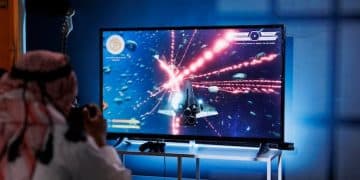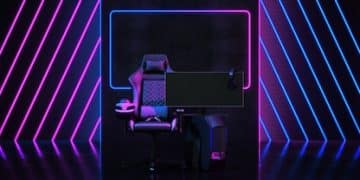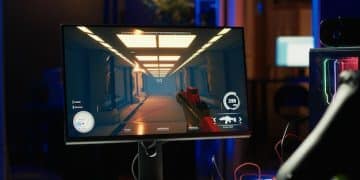Unlock 120Hz Gaming on Your 2024 TV: A Guide

Achieve peak gaming performance on your 2024 TV by ensuring it supports HDMI 2.1, configuring console display settings for 120Hz output, and selecting game titles optimized for high refresh rates to fully immerse yourself in a smoother, more responsive gaming experience.
The landscape of gaming technology evolves at an astonishing pace, and at the heart of this evolution lies the pursuit of unparalleled visual fidelity and responsiveness. For serious gamers, the dream of ultra-smooth gameplay at higher frame rates has long been a pursuit. With the advent of 2024 television models, achieving this dream is now more accessible than ever. This guide focuses on Unlocking 120Hz Gaming on Your 2024 TV: A Step-by-Step Guide, turning your gaming sessions into a fluid, immersive experience.
The 120Hz Advantage: Why It Matters for Gaming
For many years, 60Hz televisions were the standard, providing a stable but often limiting experience for fast-paced games. The transition to 120Hz represents a significant leap, fundamentally altering how games are displayed and perceived. This higher refresh rate means the TV can draw new images twice as fast as its 60Hz counterpart, leading to visibly smoother motion and reduced input lag.
The difference between 60Hz and 120Hz is particularly pronounced in genres where quick reflexes and fluid movement are paramount. Think of competitive first-person shooters, racing games, or even fast-paced action RPGs. Every additional frame rendered contributes to a more accurate and responsive interaction with the game world. This isn’t just about aesthetics; it’s about gaining a competitive edge and enhancing overall immersion, providing a more detailed visual stream to your eyes.
Understanding Refresh Rate and Its Impact
Refresh rate, measured in Hertz (Hz), defines how many times per second a display refreshes its image. A 120Hz screen updates 120 times every second. This capability works in tandem with high frame rates (frames per second, or FPS) generated by your gaming console or PC. When the refresh rate matches or exceeds the frame rate, the result is tear-free, judder-free motion, which is crucial for dynamic gaming.
- Smoother Visuals: Objects in motion appear less blurry and more defined.
- Reduced Input Lag: The latency between your input and the on-screen action is minimized.
- Enhanced Immersion: A more fluid world makes the gaming experience feel more natural.
- Competitive Edge: Faster visual updates mean you can react quicker to in-game events.
Beyond the technical specifications, the practical benefit of 120Hz is a gaming experience that feels more connected and immediate. Your brain processes a higher volume of visual information, leading to quicker decision-making and a more intuitive connection with the game. This elevated responsiveness is a game-changer, literally, empowering players to perform at their best.
Ultimately, investing in a 120Hz capable TV for gaming in 2024 isn’t just about having the latest technology; it’s about significantly upgrading your interactive experience. It prepares you for future game titles that increasingly leverage these higher refresh rates, ensuring your setup remains cutting-edge and provides superior performance for years to come.
Checking Your 2024 TV for 120Hz Capability
Before diving into settings adjustments and game choices, the crucial first step is verifying that your 2024 television genuinely supports 120Hz. While many newer models boast this feature, it’s essential to confirm its presence and understand the necessary prerequisites. Not all HDMI ports are created equal, and specific TV settings can impact performance. This foundational check ensures you’re building on solid ground.
Identifying your TV’s capabilities typically involves consulting its specifications, either through the manufacturer’s official website, the product manual, or the on-screen display menu. Look for terms like “120Hz Native Refresh Rate” or “HDMI 2.1 compatibility.” The presence of HDMI 2.1 is particularly vital, as it provides the bandwidth necessary to transmit 4K resolution at 120 frames per second.
Verifying HDMI 2.1 Ports and Settings
HDMI 2.1 is the backbone of high-resolution, high-refresh-rate gaming. Without it, your TV might support 120Hz at lower resolutions, or not at all from external devices. Most 2024 TVs with 120Hz capability will have at least one, if not multiple, HDMI 2.1 ports. These ports might be labeled explicitly, or you might need to refer to your TV’s manual to identify them. It is crucial to use the correct port for your high-performance console.
Once identified, ensure these ports are configured correctly within your TV’s settings. Many TVs have an option to enable “Enhanced HDMI,” “HDMI Ultra HD Deep Color,” or similar settings for each HDMI input. This unlocks the full bandwidth of HDMI 2.1, allowing for 120Hz signals. Without this enabled, even a 2.1 port might default to a lower bandwidth, limiting your frame rate and resolution potential.
- Consult the Manual: The quickest way to confirm HDMI 2.1 port locations and specific settings.
- On-Screen Display (OSD): Navigate through the TV’s menu to “Picture,” “Inputs,” or “Advanced Settings” to find HDMI options.
- Firmware Updates: Ensure your TV’s firmware is up to date, as manufacturers often release updates that improve HDMI 2.1 compatibility and performance.
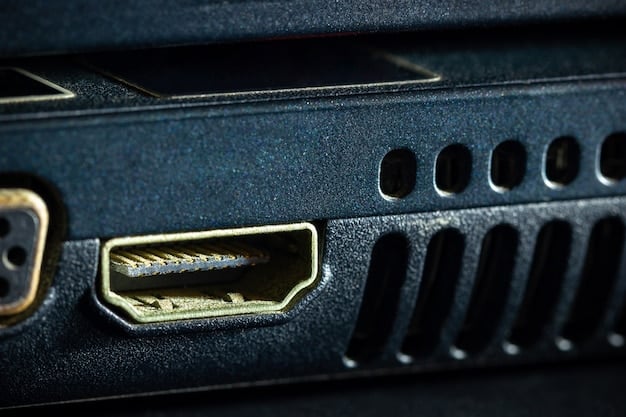
Additionally, some TVs may require dedicated “Game Mode” activation to bypass certain picture processing features that introduce input lag. While not directly related to 120Hz, ensuring Game Mode is active complements the high refresh rate by reducing overall latency, providing a snappier response from your game controller to the screen. Failing to enable these settings can result in a less than optimal 120Hz experience, even if your hardware technically supports it.
Confirming your TV’s 120Hz and HDMI 2.1 capabilities, along with the correct port and picture settings, is a non-negotiable step. It sets the stage for a truly optimized gaming setup, preventing frustration down the line when your console isn’t outputting at its full potential. This diligent check ensures you maximize the advanced features of your 2024 television for a premium gaming experience.
Configuring Your Gaming Console for 120Hz Output
Once you’ve confirmed your 2024 TV’s 120Hz and HDMI 2.1 capabilities, the next critical step is to configure your gaming console to output signals at this higher refresh rate. Modern consoles like the PlayStation 5 and Xbox Series X/S are designed to take advantage of these advanced display features, but they often require specific settings adjustments. This isn’t always a plug-and-play scenario; a few tweaks are usually necessary to unlock the full potential of your setup.
The process generally involves navigating through your console’s display or screen settings, identifying options related to resolution and refresh rate. It’s important to remember that not all games support 120Hz, and even for those that do, the console might prioritize higher resolution (e.g., 4K) over the higher frame rate by default. You might need to make an explicit choice between the two depending on your preference and the game’s optimization.
PlayStation 5 Settings
For PlayStation 5 owners, enabling 120Hz is a straightforward process, though it has specific requirements. First, ensure your PS5 is directly connected to a 120Hz compatible HDMI 2.1 port on your TV. Then, navigate to the system settings to adjust the display output. The PS5 intelligently detects compatible displays and will often present the option to enable 120Hz if available. The console also supports Variable Refresh Rate (VRR), which significantly enhances smoothness by synchronizing the console’s frame rate with the TV’s refresh rate, eliminating screen tearing.
In the PS5’s menu:
- Go to Settings > Screen and Video.
- Under Video Output, look for Output 120 Hz Output. Set this to “Automatic.”
- For VRR, ensure VRR is set to “Automatic” or “Always On” if your TV supports it.
- Make sure your game is updated and supports a 120Hz performance mode.
Some games on PS5 allow you to choose a “Performance Mode” or “Fidelity Mode.” Performance Mode usually prioritizes higher frame rates (including 120Hz when supported), while Fidelity Mode emphasizes resolution and graphical detail, often at 30 or 60 FPS. Always select the performance option to get the 120Hz experience. Failing to do so, or connecting to an incompatible port, will result in the console defaulting to a lower refresh rate.
Xbox Series X/S Settings
Xbox Series X and Series S consoles offer similar flexibility for 120Hz gaming. Like the PS5, a direct connection to an HDMI 2.1 port is essential. The Xbox interface makes it relatively easy to verify and set your display options, providing clear indicators of what your connected TV supports. The Xbox also prominently features VRR capabilities, which are crucial for maintaining fluidity in games with fluctuating frame rates.
In the Xbox menu:
- Go to Settings > General > TV & display options.
- Under Display, set Refresh rate to “120 Hz”.
- Ensure Allow variable refresh rate and Allow auto low-latency mode are checked under Video modes.
The Xbox often has a “4K TV details” section that provides a comprehensive breakdown of what your TV can support, including resolution, HDR, and 120Hz capabilities. This is an excellent tool for troubleshooting and confirming your setup. Most games will have a mode selector allowing you to specifically choose between a “performance” or “quality” setting, with performance typically targeting higher frame rates.
Properly configuring your console’s display settings is paramount for unlocking 120Hz gaming. This process involves more than just plugging in; it requires a deliberate choice within the console’s menu to prioritize the higher refresh rate. By meticulously adjusting these settings, you ensure your gaming sessions fully leverage the advanced capabilities of both your console and your 2024 TV, delivering an unprecedented level of fluidity and responsiveness.
Choosing Games Optimized for 120Hz Performance
While having a 120Hz TV and a compatible console are essential, the full 120Hz gaming experience hinges on the games themselves. Not every title will support this higher refresh rate, and even among those that do, implementation can vary. Understanding which games are optimized for 120Hz and how to activate their respective performance modes is crucial for truly appreciating the visual benefits. This involves a bit of research and diligence on the part of the gamer.
Developers typically build games with specific performance targets in mind. For 120Hz to be achievable, the game engine must be able to render frames at a sustained rate of 120 FPS or higher. This often means making compromises in graphical fidelity, such as reducing resolution, texture quality, or particle effects. The choice between a “Fidelity Mode” (higher resolution/graphics, lower FPS) and a “Performance Mode” (lower resolution/graphics, higher FPS) is common in many modern titles.
Identifying 120Hz Supported Titles
The list of games supporting 120Hz output continues to grow, particularly for popular multiplayer titles and first-party console exclusives. Information regarding 120Hz support is usually found on the game’s official website, its store page (e.g., PlayStation Store, Xbox Store), or within dedicated gaming news outlets and communities. User forums and review sites are also excellent resources for real-world performance insights.
- Check Game Patches: Many games receive post-launch updates adding 120Hz modes.
- Read Reviews: Tech reviews often detail performance modes and frame rate targets.
- In-Game Settings: Always explore the display or graphics settings within the game itself for specific options.
Some notable examples of games that often support 120Hz on compatible consoles include popular competitive shooters like Call of Duty: Modern Warfare III and Halo Infinite, where every frame counts. Racing games such as Forza Horizon 5 also benefit immensely from the added fluidity. Even certain single-player titles are now offering performance modes that target 120Hz, providing a smoother experience outside of competitive play.
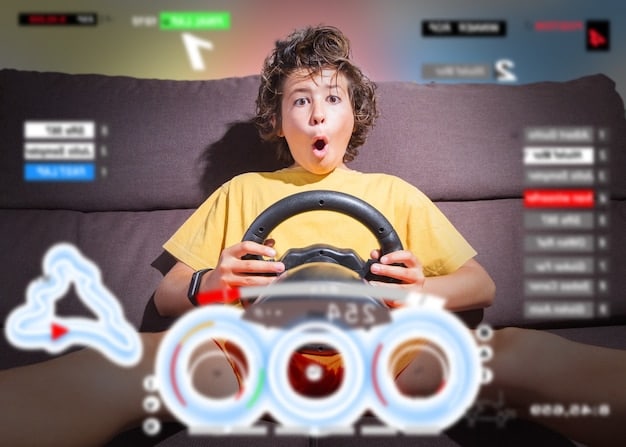
Activating these modes typically happens within the game’s own settings menu, separate from the console’s system-level display settings. Look for options labeled “Graphics Mode,” “Performance vs. Quality,” or similar choices. It’s crucial to select the specific mode that prioritizes frame rate for the 120Hz experience. Without this selection, even if your console and TV are set up correctly, the game might default to a 60Hz mode to prioritize visual quality.
The journey to 120Hz gaming concludes with selecting and configuring the right titles. By actively seeking out games optimized for high refresh rates and choosing their respective performance modes, you unlock the full potential of your 2024 TV and console. This thoughtful approach ensures that every gaming session delivers the buttery-smooth visuals and instantaneous responsiveness that high refresh rate gaming promises.
Optimizing Your Gaming Environment: Beyond the TV
Achieving truly immersive 120Hz gaming extends beyond merely having a compatible TV and console. The surrounding environment and peripheral equipment play a significant role in maximizing your experience. Factors such as lighting, audio setup, and network stability can subtly, yet significantly, impact how you perceive and enjoy high-refresh-rate gameplay. Optimizing these elements ensures that your cutting-edge visual setup isn’t bottlenecked by overlooked details.
Consider the room lighting. Excessive glare on your screen can diminish the perceived clarity of even the smoothest visuals. Strategic placement of lights or the use of ambient lighting can reduce eye strain and improve overall picture quality. Similarly, the audio experience is integral to immersion. High-quality headphones or a surround sound system can enhance positional audio cues, adding another layer to the responsive gameplay that 120Hz enables. These environmental tweaks elevate the gaming experience from merely watching to truly participating.
Connectivity and Cables
The weakest link in a high-performance setup is often an inferior cable. For 120Hz gaming at resolutions like 4K, using certified Ultra High Speed HDMI cables (often simply referred to as HDMI 2.1 cables) is non-negotiable. These cables are designed to handle the massive bandwidth required for uncompressed 4K@120Hz signals, ensuring stable and clear transmission. Older HDMI cables simply won’t cut it and can lead to signal dropouts, flickering, or a complete inability to achieve the desired refresh rate.
- Certified Cables: Look for the “Ultra High Speed HDMI” logo on the packaging.
- Cable Length: Shorter cables are generally more reliable for high bandwidth.
- Avoid Adapters: Direct connections are always preferred to minimize signal loss.
Regarding network connectivity (especially for online multiplayer), a stable, wired Ethernet connection is always superior to Wi-Fi. While modern Wi-Fi standards like Wi-Fi 6 (802.11ax) offer impressive speeds, they can be susceptible to interference and variable latency, which is detrimental to competitive online gaming. A direct Ethernet connection provides a consistent, low-latency pathway between your console and the internet, crucial for maintaining a responsive experience at 120Hz.
Beyond hardware, personal comfort also plays a role. An ergonomic gaming chair, proper viewing distance from your TV, and breaks to prevent eye fatigue contribute to longer, more enjoyable gaming sessions. These often-overlooked aspects cumulatively enhance the overall experience, ensuring you can fully appreciate the fluid motion and reduced lag that 120Hz gaming provides on your 2024 TV.
Optimizing your gaming environment is about creating a holistic experience. By addressing factors like cable quality, network stability, and personal comfort, you eliminate potential bottlenecks and enhance immersion. This comprehensive approach ensures that your pursuit of 120Hz gaming on your 2024 TV leads to not just technical superiority, but also unmatched enjoyment and performance.
Troubleshooting Common 120Hz Issues
Even with the most meticulous setup, issues can sometimes arise when trying to achieve 120Hz gaming. These problems can range from the TV not displaying 120Hz, to flickering screens, or games simply feeling like they’re running at a lower refresh rate. Troubleshooting requires a systematic approach, checking each component in the chain to identify and resolve the bottleneck. Don’t be discouraged if your initial setup doesn’t immediately yield the desired results; common solutions often pinpoint the problem quickly.
The most frequent culprit is often a misconfigured setting or an oversight in hardware compatibility. It’s easy to assume everything is working as intended, but specific steps are critical. From ensuring the TV’s firmware is up to date, to verifying individual port settings, each detail plays a role. A methodical check of each link in the signal chain from console to screen will usually reveal the root cause of any performance hiccup. Patience and persistence are key when debugging these technical challenges.
Common Problems and Solutions
One common issue is the TV not showing a 120Hz option or defaulting to 60Hz. This often points back to the TV’s HDMI port settings. Ensure that the specific HDMI input you’re using has “Enhanced HDMI” or a similar high-bandwidth mode enabled in the TV’s menu. Some TVs also have specific HDMI ports designated for higher bandwidth, so always double-check your TV manual for the correct port. If your TV has multiple HDMI 2.1 ports, try switching to a different one.
- TV Firmware: Always check for and install the latest TV firmware updates.
- HDMI Cable: Verify you are using a certified Ultra High Speed HDMI 2.1 cable.
- Console Settings: Reconfirm 120Hz output is set to “Automatic” or “On” in your console’s display settings.
- Game Mode: Ensure “Game Mode” or similar low-latency modes are active on your TV.
Another frequent problem is screen flickering or intermittent signal loss. This almost invariably indicates an issue with the HDMI cable. Even if a cable is advertised as HDMI 2.1, cheaper or uncertified versions might struggle with the continuous high bandwidth required for 4K@120Hz. Investing in a high-quality, certified Ultra High Speed HDMI cable from a reputable brand can resolve this immediately. Also, ensure the cable is securely plugged into both the console and the TV, as a loose connection can cause similar symptoms.
Sometimes, a game supports 120Hz, but it feels like it’s not running as smoothly as expected. This might be due to the game’s internal settings prioritizing graphical fidelity (e.g., “Quality Mode”) over frame rate (“Performance Mode”). In the game’s menu, explicitly select the performance option. If the problem persists, try restarting both your console and your TV. A full power cycle can often clear minor glitches and re-establish proper communication between devices.
Troubleshooting 120Hz issues involves systematically checking the console, the HDMI cable, and the TV settings. By addressing these common pitfalls, you can quickly diagnose and resolve most performance problems, ensuring your 2024 TV delivers the seamless, high-refresh-rate gaming experience it was designed for. Remember, patience and attention to detail are your best allies in fine-tuning your optimal gaming setup.
Future-Proofing Your Gaming Setup
As gaming technology continues its rapid evolution, the concept of future-proofing your setup becomes increasingly relevant. While your 2024 TV offers cutting-edge 120Hz capabilities, thinking ahead ensures your investment remains valuable and provides a premium experience for years to come. This involves considering emerging trends, connectivity standards, and the capabilities of future gaming hardware. A forward-looking approach safeguards your setup against early obsolescence.
One key aspect of future-proofing is recognizing the importance of HDMI 2.1 and its full feature set. While today’s focus is on 4K@120Hz, HDMI 2.1 also supports features like Dynamic HDR (HDR10+, Dolby Vision) and Auto Low Latency Mode (ALLM), which enhance the gaming experience. Ensuring your TV and future consoles fully support these elements guarantees robust compatibility. The bandwidth provided by HDMI 2.1 is critical, as it scales to support even higher resolutions and refresh rates that might become standard in the next generation of gaming.
Beyond HDMI 2.1: Emerging Technologies
While HDMI 2.1 is the current king, the industry is always looking forward. Technologies like DisplayPort, predominantly used in PC gaming monitors, offer similar high-bandwidth capabilities, and could potentially see more integration with home entertainment systems in the future. Similarly, advancements in wireless display technologies could one day offer high-refresh-rate gaming without the need for cables, though this is still largely theoretical for console gaming at 120Hz and beyond.
- VRR Evolution: Look for TVs with robust Variable Refresh Rate (VRR) implementations (HDMI Forum VRR, FreeSync Premium Pro, G-Sync Compatible).
- Cloud Gaming: Consider your internet bandwidth for future high-fidelity cloud gaming services.
- Next-Gen Consoles: Your HDMI 2.1 TV is prepared for even more demanding future console generations.
Another area for future-proofing is the adoption of advanced display panel technologies. While OLED and Mini-LED are currently at the forefront, research into Micro-LED and other self-emissive technologies promises even greater contrast, brightness, and color accuracy. Investing in a TV with a leading panel technology today ensures you’re at the cutting edge of visual quality, prepared for the increasingly photorealistic graphics of future games.
Finally, consider the overall ecosystem. As consoles and game engines become more powerful, game sizes increase, and digital libraries expand. Having sufficient internal storage or external SSD solutions is crucial. Cloud gaming is also an emerging trend that could significantly impact how we access and play games, making robust internet connectivity a vital component of a future-proof setup. By thoughtfully anticipating these trends, you ensure your 2024 TV remains a central, capable component of your evolving gaming universe.
Future-proofing in gaming is a continuous process of informed decisions. By understanding the foundational technologies like HDMI 2.1, staying aware of emerging display and connectivity standards, and investing in robust infrastructure, you ensure your 2024 TV continues to deliver a state-of-the-art gaming experience, adapting seamlessly to the innovations yet to come in the vibrant world of interactive entertainment.
| Key Aspect | Brief Description |
|---|---|
| 📺 TV Compatibility | Ensure your 2024 TV has native 120Hz support and HDMI 2.1 ports for optimal performance. |
| 🎮 Console Setup | Adjust your PS5 or Xbox Series X/S display settings to output at 120Hz and enable VRR. |
| 🕹️ Game Optimization | Select games that offer 120Hz performance modes and activate them within game settings. |
| 🔌 Connectivity | Use certified Ultra High Speed HDMI 2.1 cables for stable and high-bandwidth signal transmission. |
Frequently Asked Questions
▼
120Hz refers to a display’s refresh rate, meaning it refreshes the image 120 times per second. For gaming, this translates to significantly smoother motion, reduced input lag, and a more responsive experience, especially in fast-paced games where quick reactions are crucial. It minimizes motion blur and screen tearing.
▼
Yes, to achieve 120Hz at 4K resolution, you need a certified Ultra High Speed HDMI 2.1 cable. Older HDMI cables (e.g., HDMI 2.0) do not have enough bandwidth to transmit 4K@120Hz signals, which can lead to lower refresh rates, flickering, or no signal at all.
▼
Check your TV’s settings for the specific HDMI port you’re using; enable “Enhanced HDMI” or “Game Mode” to unlock full bandwidth. Also, ensure your console’s display settings are set to output at 120Hz, and that the game you’re playing has a performance mode enabled for 120Hz support. A proper HDMI 2.1 cable is also essential.
▼
No, not all games support 120Hz. Many newer titles offer a “Performance Mode” that prioritizes higher frame rates, including 120Hz, often by reducing resolution or graphical detail. Always check the game’s settings or official information to see if it supports a 120Hz mode specifically.
▼
VRR (Variable Refresh Rate) synchronizes the TV’s refresh rate with the console’s frame rate. This eliminates screen tearing and reduces stuttering, creating a much smoother visual experience, especially when frame rates fluctuate. When combined with 120Hz, VRR ensures exceptional fluidity and responsiveness, even during intense action.
Conclusion
Achieving 120Hz gaming on your 2024 TV is a transformative experience, pushing the boundaries of visual fluidity and responsiveness for immersive gameplay. It’s a journey that starts with verifying your TV’s capabilities, meticulously configuring your console, and choosing games that leverage this high refresh rate. By understanding the nuances of HDMI 2.1, optimizing your physical setup, and skillfully troubleshooting common issues, you unlock a level of gaming precision and enjoyment previously confined to high-end PC rigs. Your 2024 TV is more than just a display; it’s a gateway to an enhanced gaming universe, ready to deliver unparalleled visual fidelity and a competitive edge.
